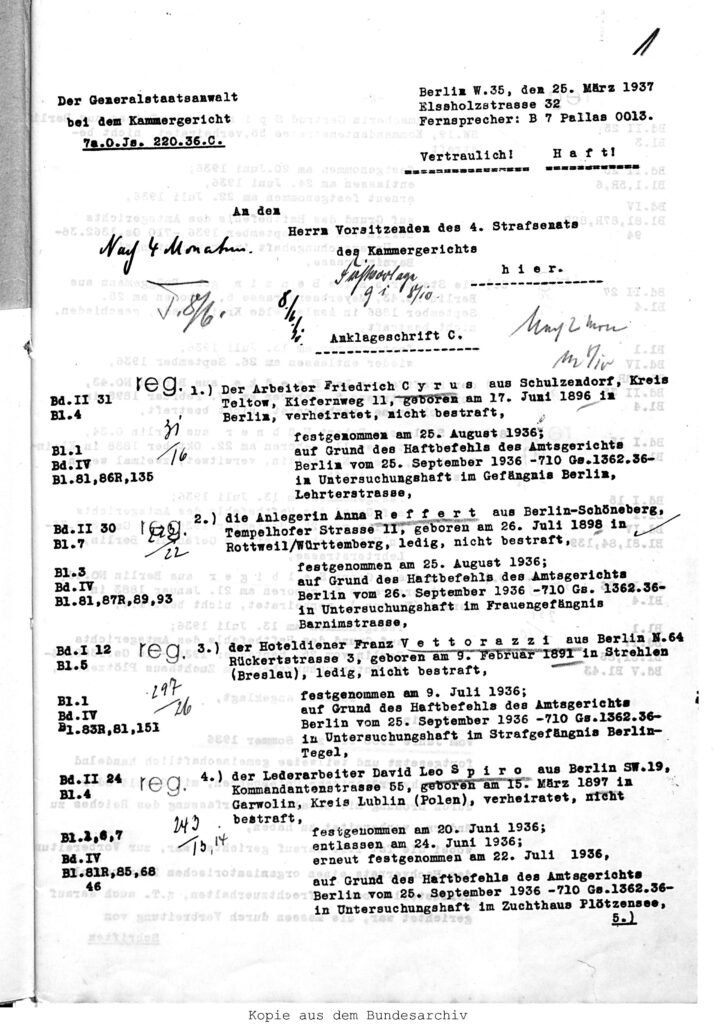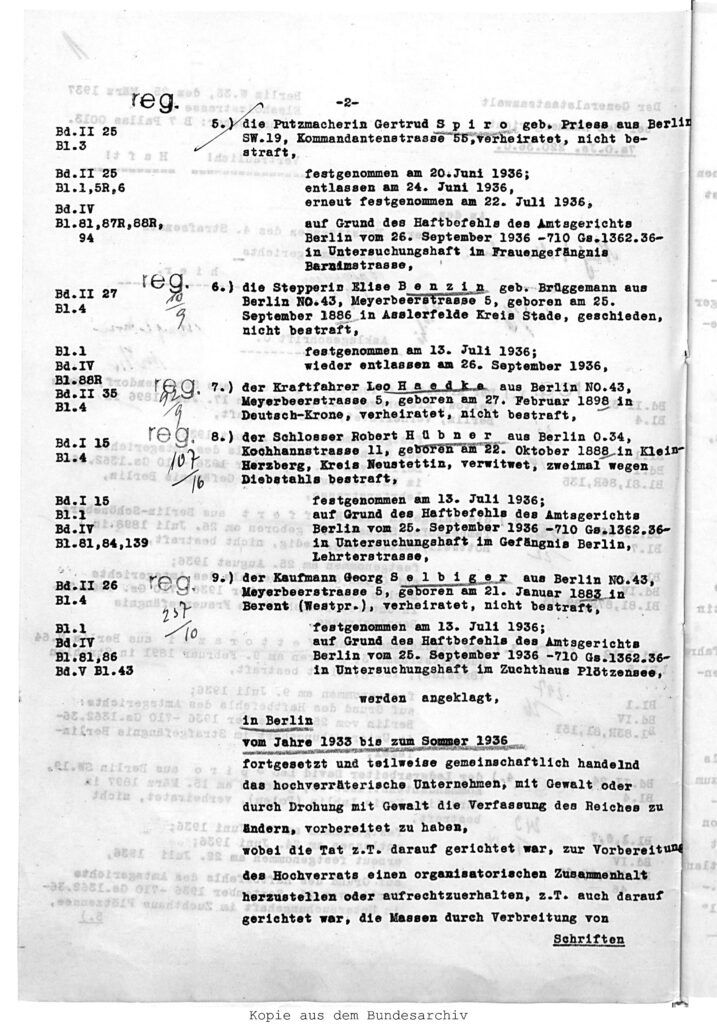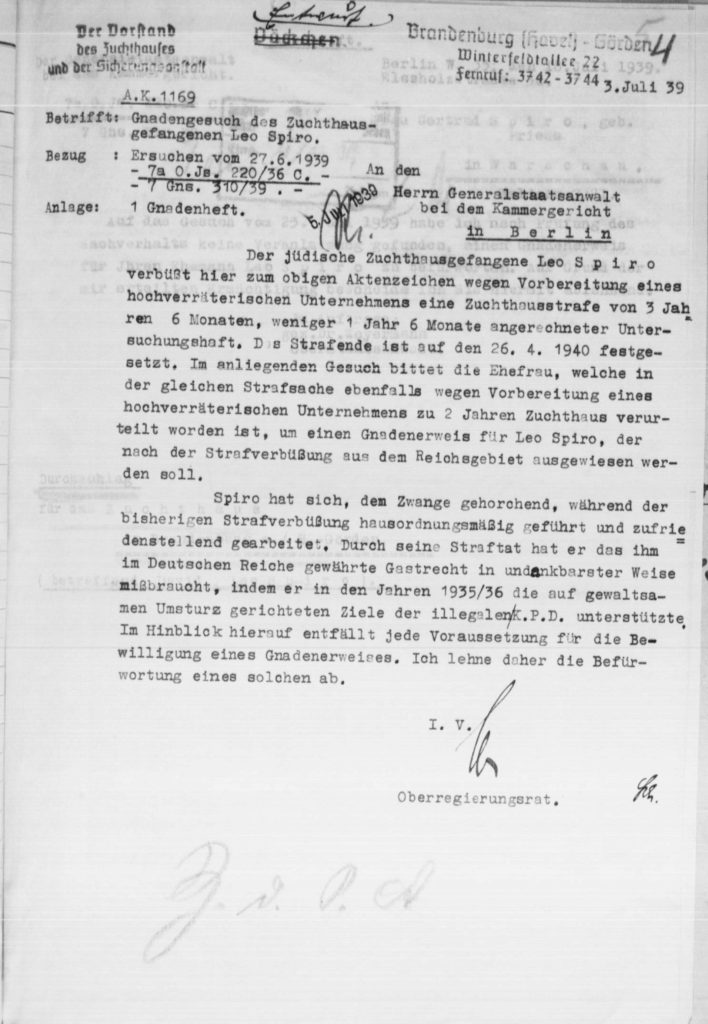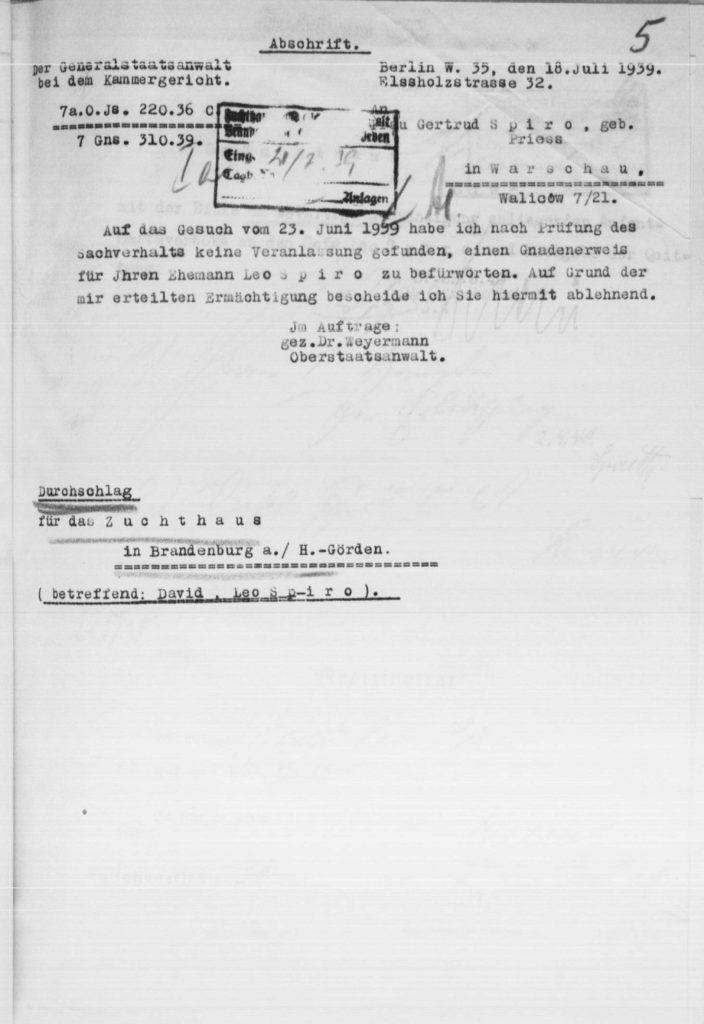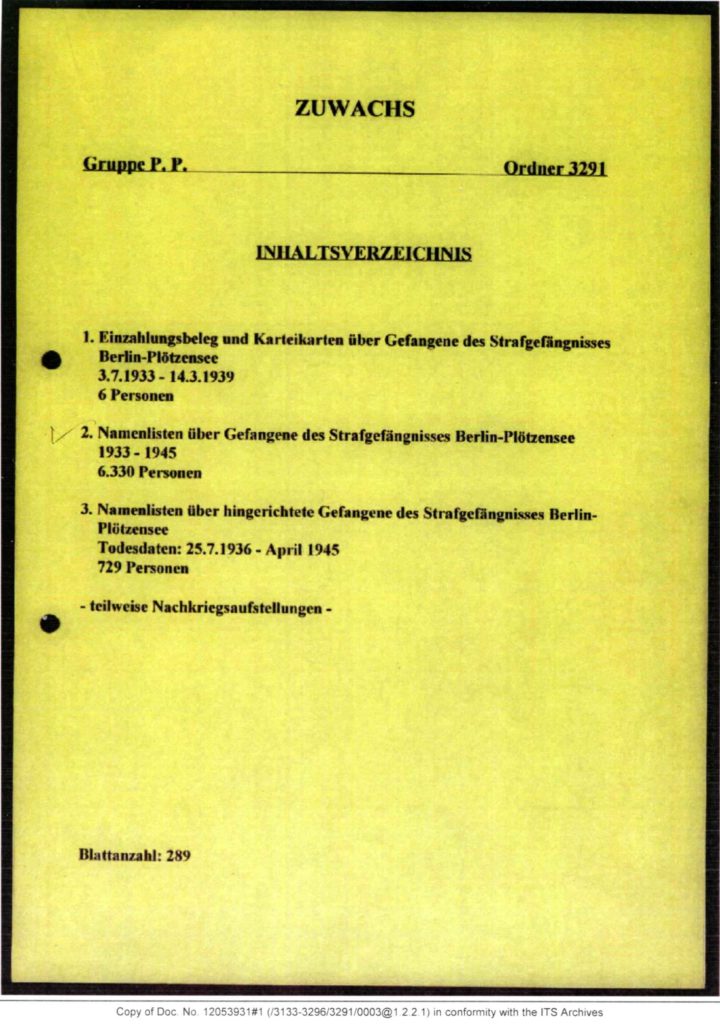Das Bundesarchiv Trial Records
According to Widerstand in Berlin gegen das NS-Regime 1933 bis 1945 (Resistance in Berlin against the Nazi Regime 1933-1945), Leo and Gertrud Spiro were put on trial in Berlin in 1938. Trying to locate their court records, I contacted the editor of the book Dr. Gunter Wehner, a scholar of the German resistance. Dr. Wehner is 83 years old, and a well-known researcher at the Bundesarchiv (National Archives) in Berlin-Lichterfelde where the records are archived.
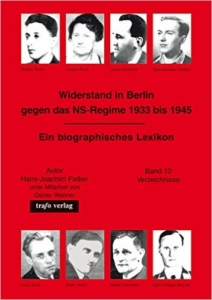
Dr. Wehner offered to help by locating trial records in the Bundesarchiv that mentioned Leo and Gertrud, including those included in his book. Although we would have to go through official channels to order copies of what he found, Dr. Wehner told me he would review the information included in each file he discovered. The Archives only copies whole files, even if the subjects of interest are a small part of what is available; having Dr. Wehner look at the files first would allow us to know which ones were worth copying.
A few weeks later, I was notified by Herr Andreas Grunwald, Archivist at the Bundesarchiv, that Leo and Gertrud were mentioned in quite a few of the Archive’s collections, but after some research by Dr. Wehner, it was discovered that this was incorrect. Only one collection included information relevant to the Spiros – the court proceedings of the resistance fighter Margarete Kaufmann who was arrested in 1936 for publishing and distributing illegal literature. The Spiros were arrested on 20 June 1936 as her associates.
The Kaufmann court proceedings consisted of over a thousand pages. Fortunately Dr. Wehner discovered that only file R 3001/ 181466, dated 25 March 1937 – Berichtsakte des Generalstaatsanwalts bei dem Kammergericht in Berlin an das Reichsjustizministerium (Report of the Attorney General at the Court of Appeal in Berlin at the Ministry of Justice) – included information on Leo and Gertrud.
Scanned images of the court proceedings arrived in my mailbox the day I was leaving for a trip to the East Coast. The folder was a goldmine of new information about the Spiros.
The date of the proceedings was 25 March 1937. The individuals on trial were:
- Friedrich Cyrus, laborer, resident of Schulzendorf, Kries Teltow, Kieferweg 11, born 17 June 1896 in Berlin; married, no previous record. Arrested 25 August 1936; on the basis of the arrest warrant issued by the District Court on 25 September 1936 -710 Ge.1362.36- in custody in the Berlin prison on Lehrterstrasse.
- Anna Reffert, investor, resident of Berlin-Schoenberg, Templehofer Strasse 11, born 26 Jul 1898 in Rottweil/Wurttemberg, single; no previous record; on the basis of the arrest warrant issued by the District Court on 25 September 1936 -710 Ge.1362.36- in custody in the women’s prison in Barimstrasse.
- Franz Vettorazzi, bellhop, resident of Berlin N. 64, Ruckerstrasse 3, born 9 February 1891 in Strehlen (Breslau), single; no previous record. Arrested 25 August 1936; on the basis of the arrest warrant issued by the District Court on 25 September 1936 -710 Ge.1362.36- in custody in the Berlin-Tegel prison.
- David Leo Spiro, leatherworker, resident of Berlin SW. 19, Kommandantenstrasse 55, born 15 March 1897 in Garwolin, Kreis Lublin, Poland; married; no previous record. Arrested on 20 June 1936, released 24 June 1936, re-arrested 22 July 1936; on the basis of the arrest warrant issued by the District Court, on 25 September 1936 -710 Ge.1362.36- in custody in the Plotzensee Penetentiary.
- Gertrud Spiro nee Priess, milliner, resident of Berlin SW. 19, Kommandantenstrasse 55, married; no previous record. Arrested on 20 June 1936, released 24 June 1936, re-arrested 22 July 1936; on the basis of the arrest warrant issued by the District Court on 25 September 1936 -710 Ge.1362.36- in custody in the women’s prison in Barimstrasse.
- Elise Benzin nee Bruggemann, tap dancer, resident of Berlin No. 43, Meyerbeerstrasse 5, born 25 September 1886 in Asslerfelde, Kreis Stade; divorced; no previous record. Arrested 13 July 1936, released again 26 September 1936.
- Leo Haedke, driver, resident of Berlin No. 43, 5 Meyerbeerstrasse, born 27 February 1898 in Deutsch-Krone married, no previous record.
- Robert Hubner, locksmith, resident of Berlin No. 34, 11 Kochhannstrasse, born 22 October 1888 in Klein Herzberg, Kreis Neustettin, widowed, twice sentenced for theft. Arrested 13 July 1936, on the basis of the arrest warrant issued by the District Court on 25 September 1936 -710 Ge.1362.36- in custody in the Berlin prison on Lehrterstrasse.
- Georg Selbiger, salesman, resident of Berlin No. 43, Meyerbeerstrasse 5, born 21 January 1883 in Berent (West Prussia), married, no previous record. Arrested on 20 June 1936, released 24 June 1936, re-arrested 22 July 1936; on the basis of the arrest warrant issued by the District Court, on 25 September 1936 -710 Ge.1362.36- in custody in the Plotzensee Penetentiary.
According to the records, these nine defendants were accused of having prepared to commit high treason in Berlin against the Constitution from 1933 until Summer 1936, by influencing the masses by the distribution of written material.
There is biographical information given for Leo and Gertrud:
The defendant Leo Spiro, a Jew, attended a private school in Warsaw run by his father between the ages of 6 and 14 years old. After that he worked as a leather worker. After the occupation of the Warsaw by the Germans during the war, he moved to Freiberg, Silesia where he worked in the defense industry. After the end of the war, he worked in Berlin as a porter. Since 1922 he has worked as a leather worker again. In 1932 he founded his own workshop.
The defendant was not formerly politically affiliated. Before its political takeover, he belonged to the union of upholsterers and paperhangers.
The defendant Gertrud Spiro attended her village school in East Prussia. In 1912, her parents moved to Berlin, where she continued her elementary school education. After she graduated from the 2nd class, she went to work(?) until she was 18. After that, she continued her education as a milliner, and later worked from home in this profession until she married in 1923.
The defendant was not formerly politically affiliated.
The two defendants were acquainted with the Communist leader Margarete Kaufmann for some time. Their friendship resulted in many mutual visits, especially since in 1933 Leo and Margarete were found to be distant relatives. When Margarete Kaufmann stayed at their home, she often discussed political questions with them. During this time, she hinted that she was active with the illegal KDP (Communist Party). She tried to convince the defendants that Communism was the only right way.
In 1935, as “Emi”-Frau of the Berlin Central District, Margarete Kaufmann had to provide for the accommodation of Communist fugitives. She was assigned to a certain “Anton” by the Emi-Leader of the area, who also went by the alias “Kurt Lewinski”, and who for a while had been in the Berlin Central District. Margaret Kaufmann brought this man to the two defendants and told them that he was a Pole who was a fugitive who could not register with the police. The defendants were ready to take him into their house. That they didn’t know that this was a politically illegal activity is hard to believe, considering their close relationship to Margarete Kaufmann.
In the fall of 1935, an official meeting took place illegally in the apartment of the defendants, during which Anton described a number of allegations against the then Organization Leader Urbschat that had to be discussed. Besides Urbschat and “Anton”, Margarete Kaufmann appeared at the meeting with a man known as “Hans” who served at a higher level in the area. The meeting led to the result that Urbschat quit his position and was replaced by Margarete Kaufmann. Although the defendants did not take part in the meeting, they were aware of it. The defendant Leo Spiro opened the door himself for Hans, and chatted with him in a way that Urbschat had the impression that the defendant was well known to Hans.
In early 1936, Margarete Kaufmann feared that the State Police would organize a search of her house. She entrusted her typewriter to the defendants, who were aware that the machine was used to produce illegal inflammatory publications. At first, the defendants kept the machine at their house, until they were asked by Margarete Kaufmann on 6 June 1936 to bring the machine immediately to the home of the co-defendant Röhrs (Prosecution B). Gertrud Spiro carried out the transfer at noon the same day. Margarete Kaufmann arrived while she was still at the home of her in-laws the Röhrs. She handed the defendant jewelry and a pawn ticket for a watch, and asked them to keep them safe for her. The reason she gave was that she was afraid of her Aryan boyfriend, by which they assumed that he had betrayed her.
The defendants have confessed to only part of this.
So far, they deny that they were won over by the statements of Margarete Kaufmann and Gustav Urbschat.
*****
There are similar passages that describe the crimes of the other defendants. Later pages in the records give more details about Leo and Gertrud.
In the Name of the German People!
In the criminal matter against:
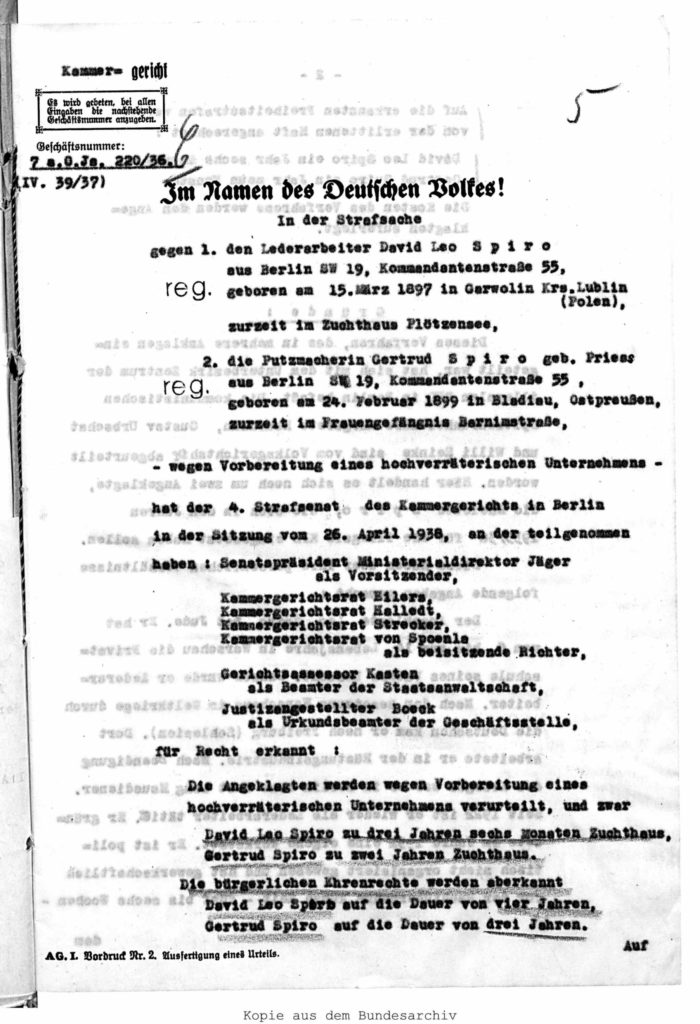
- The leatherworker David Leo Spiro from Berlin SW 19, Kommandentenstrasse 55, born 15 March 1897 in Garwolin, Kreis Lublin, Poland, now in the Plötzensee penetentiary.
- The milliner Gertrud Spiro nee Priess from Berlin SW 19, Kommandentenstrasse 55, born 24 February 1899 in Bladiau, East Prussia, now in the Barimstrasse women’s prison, for preparing to commit high treason.
The following took part in the Fourth Criminal Division of the Appeals Court session of 26 April 1938 in Berlin:
Chariman: Senate President Ministerial Director Jager
Appeals Court Judge Eilers
Appeals Court Judge Halledt
Appeals Court Judge Strecker
Appeals Court Judge von Spoenle
As Associate Judges:
Court Assessor Kaster as the public prosecutor
Court clerk Boeck as recorder
The accused are sentenced for preparing to commit high treason:
David Leo Spiro to three years six months in prison
Gertrud Spiro to two years in prison.
Their civil rights are suspended:
David Leo Spiro for a period of four years
Gertrud Spiro for a period of three years.
This time period shall take into account time already served:
David Leo Spiro – one year six months
Gertrud Spiro – one year nine months
This trial, divided into several indictments, has dealt with the illegal KDP in the subdistrict Berlin Cental. The Communists Margarete Kaufmann, Gustav Urbschat and Willi Riencke have been condemned by the people’s court. Here we address two more defendants, the Spiros, who in 1935/36 were allegedly used by the illegal KDP.
They have given the following information about themselves:
The accused Leo Spiro is a Jew. He attended a private school run by his father in Warsaw between the ages of 6 and 14 years old. After that he worked as a leather worker. After the occupation of the Warsaw by the Germans during the war, he moved to Freiberg in Silesia where he worked in the defense industry. After the end of the war, he worked in Berlin as a porter. Since 1922 he has worked as a leather worker again. In 1932 he founded his own workshop. The defendant was not formerly politically affiliated. Before its political takeover, he belonged to the union of upholsterers and paperhangers for a short time – five or six weeks.
The defendant Gertrud Spiro attended her village school in East Prussia. In 1912, her parents moved to Berlin, where she continued her elementary school education. After she graduated from the 2nd class, she went to work(?) until she was 18. After that, she continued her education as a milliner, and later worked from home in this profession until she married in 1923. Out of this marriage a child was born in 1925. The defendant was not formerly politically affiliated.
The accused, as both have stated, are familiar with the aforementioned Margarete Kaufmann, a Jew. This acquaintance developed in 1933 when Kaufmann visited Leo Spiro’s workshop and asked to have a purse repaired. She came often, and befriended Mrs. Spiro. She used this excuse to visit once or twice a week, although there were times she did not visit at all. Kaufmann was, as she testified, the “Emi”-Frau of the subdistrict Berlin Central. In 1935, she was the head of the organization in this subdistrict, and in the end of September 1935, certainly the Agit-Prop-Leader. She resigned from her post in Berlin Central in November 1935, and in the beginning of 1936 was active with the organization’s publications. Later she became a field consultant. She has testified that the accused were not informed about her illegal activities.
The defendants have also declared in the main hearing that they did not know that Kaufmann was an operative for the illegal KDP. This is impossible to believe. While they may not have been individually informed about Kaufmann’s activities, in the course of their acquaintance with her, they must have recognized that she was operating illegally, along with the others she brought to their house. From the beginning of their acquaintance, Kaufmann made the defendants understand that she disagreed with everything that was happening in the Third Reich. She often discussed Jewish issues and she spoke in general about Communism; she was always trying to influence the defendants with these discussions. At the end of 1934 or the beginning of 1935, Kaufmann introduced both defendants to the aforementioned Reinke as her boyfriend under the name “Hans”. The defendants admitted to all of this in the main trial.
As all the witnesses have testified, Reinke, who was known as “the blonde Hans”, was until the middle of June 1935 the Pol-Leader in the subdistrict Berlin Central, and from the beginning of 1936, Org-Leader in the subdistrict Stettin. He had meetings with a Communist operative known as the “dark Hans” who was a landscaper. In the beginning of January 1935, the dark Hans was brought to the defendants’ house by Kaufmann to drop in at the end of a meeting. Kaufmann explained to him that the defendants were KPD sympathizers. He understood that Kaufmann had informed the defendants about her illegal activities.
During Kaufmann’s activities in subdistrict Berlin Central, the witness was on the average at the defendants’ residence once a week or once every other week. While he was there, he occasionally wrote reports for the illegal newspaper in pencil, while the defendants stayed in the kitchen. In April or May 1935 the witness brought his foreman, the landscaper Hans, to the defendants’ residence. This happened when the witness took Hans with him to the residence of the accused because he was tired of the meetings. The witness agreed with his foreman that in case the meetings failed, they would seek out the apartment of the defendants and come together there. That never happened, however; their two meetings never failed to take place.
The witness had only met Hans once accidentally at the home of the accused. In June 1935 the witness’ activity in the subdistrict Berlin Central came to an end. His successor was at that time a woman named “Grete”. The witness assumed that the landscaper Hans had brought Grete to the residence of the accused. In June 1935, shortly before his departure for Pomerania, he visited the accused to say goodbye. On this occasion, Frau Spiro said that the “tall Grete” had been at their home. From the middle of June 1935, the witness was in Pomerania to visit his relatives. From there he wrote the defendants a letter, in which he told them he was in the hospital. He also told them about the arrests that had happened in his small neighborhood in Berlin. The witness assumed that the letter would be read to Grete or to the landscaper Hans; the purpose of this false information was to be spared from other illegal co-workers. The witness had at that time no desire to continue with illegal activities, but was afraid to say that openly. After his return from Pomerania, the witness visited the defendants a couple of times, as he says, to chat, once in October 1935 and then again in November 1935. In November 1935 he accidentally ran into the landscaper Hans at the home of the defendants. In February the witness visited the defendants to buy a pocketbook for his daughter. During this visit, he accidentally ran into the landscaper Hans again. They left the residence of the defendants together. In the street, the witness was brought up to date by Hans about further illegal activities. The witness finally visited the defendants in March or April 1936, to pick up the pocketbook he had ordered; on this occasion he accidentally ran into Kaufmann.
It follows that from the beginning of 1935 until the year 1936, there was a constant flow of Communists at the residence of the defendants.
*****
The narrative continues for several more pages, but the most important part at the end describes their sentencing:
In determining the sentence it has to be taken into account that Ms. Spiro obviously acted under the influence of Margarete Kaufmann and her husband. Therefore she is given only the most lenient sentence of two years in prison.
The penalty against Mr. Spiro must be much more severe. For him, it should be considered that he is a Jew and foreigner who has carried out extensive activities to the gross detriment of the host nation. Therefore a sentence of three years six months is ruled necessary and sufficient.
The nature of the offense requires the suspension of the civil and political rights of the defendants.
The defendant Mrs. Spiro, who has spoken openly during the main trial, is given full credit for time served since her arrest. In contrast, Mr. Spiro who was very restrained in his testimony, will be credited with only part of the time he served pre-trial.
Issued:
Berlin, May 24th 1938
Rinarer, Secretary of Justice
As registrar of the office of the Superior Court
*****
Summing up, the narrative of Leo and Gertrud’s trial from the BundesArchiv offers a few more clues about Leo and Gertrud and their activities, including:
- Gertrud as born in Bladiau in East Prussia.
- Gertrud had a sister who was married to a man named Röhrs.
- Leo and Gertrud were married in 1923 in Berlin.
- Their child (presumably daughter Sonia) was born in 1925 in Berlin.
- They were arrested on 22 July 1936 and sent to prison 25 September 1936.
- Their trial took place on 26 April 1938, with sentencing on 24 May 1938.
- Gertrud’s release date would be 25 September 1938; Leo’s would be 26 April 1940, based on their arrest date, the sentences they were given, and the credit they were given for time already served.
International Traing Service Trial Records
The records from the Berlin Archives had just arrived as I was leaving for a trip to the East Coast, where I was planning to visit the US Holocaust Memorial Museum (USHMM) in Washington DC. I am well-known there by the archivists and staff of the International Tracing Service (ITS).
While searching for information in the ITS, I came across more trial records for Leo Spiro, dating from his arrest in September 1936, his sentencing through his release on 26 April 1940. The ITS documents also include Leo’s vital information, in addition to relevant information about Gertrud.
According to these new documents, Leo Spiro was the son of Abraham Leiser Spiro and Lea nee Graf. As of 31 May 1938, the day Leo signed his personnel form, Leo and Gertrud had a 13-year-old daughter (presumably Sonia) who was living with his in-laws at 176 Brunnerstrasse, Berlin. This was the address of Gertrude’s parents, Friedrich and Maria Priess. This also checks out as the address of an Alfred Röhrs, presumably the husband of Gertrude’s unnamed sister.
It is poignant to see Leo’s signature at the bottom of the form.

The most important part of this new collection, however, is a response by the Attorney General of the Court of Appeal to a request from Gertrud for clemency for her husband Leo. It reads:
The Board of the Prison and Detention Center
Brandenburg (Havel) – Görden
Subject: Clemency for the Penitentiary Prisoner Leo Spiro
Reference: Request of 27 Jun 1939
To the Attorney General of the Appeals Court
3 July 1939
The Jewish penitentiary prisoner Leo Spiro is serving a prison sentence of 3 years 6 months, less 1 year 6 months time served, for preparing to commit a treasonable act under the above referenced case number. His release date is set at 04/26/1936. In the accompanying petition his wife requests a pardon for Leo Spiro, who is to be expelled from the Reich at the completion of his sentence. His wife was also convicted of preparing to commit treason to 2 years in prison in the same criminal case. In the accompanying petition she asks for a pardon for Leo Spiro, who is to be expelled from the Reich after his sentence is complete.
Spiro has, in obedience to his responsibilities during his present imprisonment, behaved in an orderly manner and performed satisfactorily. Through his offense, he has abused the hospitality granted to him by the German Empire, by supporting the illegal KDP in 1935-1936 with his actions aimed at its violent overthrow. In this respect, any requirement for the granting of a pardon is negated. I therefore reject the request.
Senior Administrative Officer
*****
18 Jul 1939
The Attorney General of the Appeals Court
Berlin W 35, the 18 Jun 1939
Gertrud Spiro nee Priess
in Warsaw
Walicow 7/21
At the request of 23 Jun 1939, I have, after examination of the facts, found no reason to favor a pardon for your husband Leo Spiro. On the basis of my authority, I deny your request.
On behalf of
Dr. Weyermann
Attorney General
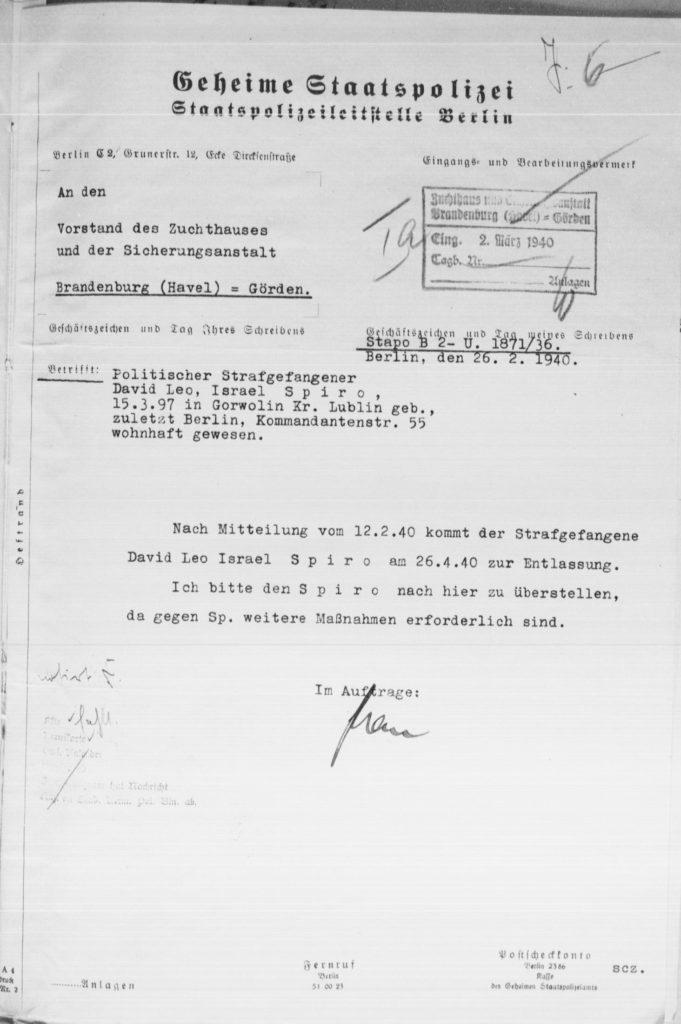
*****
There is another letter that describes Leo’s fate once he was released on 26 April 1940:
Secret Police (Gestapo)
Control Center, Berlin
To the management of the prison and the detention center
Brandenburg (Havel) Görden
Berlin, 26 February 1940
Subject: The political prisoner David Leo Israel Spiro
b. 15 March 1897, Gorwolin (sic), Kreis Lublin
Last residence: Berlin, Kommandenstrasse 55
According to the communication of 12 February 1940, David Leo Spiro is to be released on 26 April 1940.
I request that Spiro be sent here to be questioned as against Spiro there are additional charges pending.
***
The pieces of the puzzle are now falling into place. Earlier, through the ITS, we discovered the records of Leo’s imprisonment in the Berlin Plotzensee Prison:
Inhaltverzeichnis: Namenliste uber Gefängene des Strafgefängnisses Berlin-Plotensee 1933-1945. (Table of Contents: Name list of prisoners of the prison Berlin-Plotensee 1933-1945). Collection of the International Tracing Service, US Holocaust Memorial Museum, Washington DC. Leo David Spiro’s name is the first on the list.
We now know for certain that Leo Spiro never left the prison system. As stated above in the letter from the Gestapo dated 26 February 1940, and also noted in the Brandenburg Prison records (see below) when Leo Spiro had completed his sentence in Brandenburg Prison on 26 April 1940, he was transferred to the Polizeigefängnis (Police Prison) in Berlin. As we found earlier, he was then sent to Sachenhausen and after that on 7 August 1941 to Ravensbruck. He final transport was on on 25 March 1942 when he was brought to the Bernberg Euthanasia Camp outside of Berlin, and executed the same day.
Gertrude’s Fate
Thanks to the ITS trial records, we know a lot more about Gertrud’s activities before she appears in the 1941 and 1942 Generalgouvernment directories for Warsaw. We now have her chronology as:
24 February 1899
Born in Bladiau, East Prussia
1911
Moves to Berlin with her parents
1923
Marries Leo Spiro
1925
Gives birth to her daughter Sonia
1929-1931
Listed with husband Leo in Jewish city directory of Berlin
22 Jul 1936
Arrested with Leo for preparing to commit treason
25 Sep 1936
Sent to the women’s prison on Barimstrasse, Berlin
26 Apr 1938
Sentenced to 2 years in prison, with credit for time served
26 Jul 1938
Presumably released from prison
23 Jun 1939
Lives in Warsaw; requests clemency for Leo, still in prison
26 Jul 1939
Presumed end of three years probation period
1941-1942
Manages liquor and cigarette shop at 2 Nowiniarska St, Warsaw
1942
Lives at 48 Tamka St., Warsaw
11 May 1943
Arrested with daughter Sonia; taken to Pawiak Prison
24 Aug 1943
Listed on manifest for transport of 141 women to Auschwitz
25 Aug 1943
Absent from list of arrivals at Auschwitz
We also have to rule out the Gertrud Preiss (note spelling of last name) who married Stephan Gryczak, as being the same person as our Gertrud. We don’t yet know where our Gertrud was in 1929-1931, but considering she married Leo in 1923, and her daughter Sonia was born in 1925, it would have been hard for her to go to Berlin to have given birth to two sons in 1929 and 1931 with another man. According to the records of the German Court in Warsaw, Gertrud Preiss-Gryczak registered her two boys Zdislaus and Richard in 1937, at the same time our Gertrud was in the women’s prison in Berlin. The two women cannot be the same person.
Our aim in researching Gertrud Priess-Spiro is to discover the networks she belonged to, who she knew and who she worked with, hoping that somewhere in that network we can find a German soldier who had the courage to try to save a Jewish baby from the horrors of the Warsaw Ghetto. Who knows? Maybe his name was Wenglinski.
Part I: Who Am I? What is My Name? Pnina, Otwoc, and the Kaczmareks
Part II: Who Am I? What is My Name? Pnina, Wolfgang, and the Warsaw Ghetto
Part III: Who Am I? What is My Name? Gertrude and Sonia Spyra
Part IV – Who Am I, What is My Name? Wolfgang & Adele’s Eyewitness Account
Part V – Who Am I, What is My Name? Gertrude and Sonia’s Escape
Part VI – Who Am I, What is My Name? Our Search for Gertrude Spiro
Part VII – Who Am I? What is My Name? Gertrude’s Other Children?
Part VIII – Who Am I? What is My Name? Gertrud and Leo’s Trial
Part IX – Who Am I? What is My Name? Gertrude’s Sisters!
Part X: Who Am I? What is My Name? Gertrude’s Marriage and Divorce
Part XI: Who Am I? What is My Name? Berlin, Warsaw, and the German Soldier

